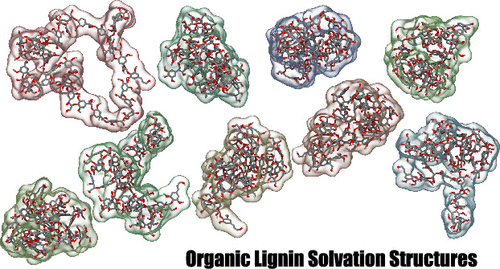当前位置:
X-MOL 学术
›
ACS Sustain. Chem. Eng.
›
论文详情
Our official English website, www.x-mol.net, welcomes your
feedback! (Note: you will need to create a separate account there.)
Molecular Lignin Solubility and Structure in Organic Solvents
ACS Sustainable Chemistry & Engineering ( IF 7.1 ) Pub Date : 2020-11-24 , DOI: 10.1021/acssuschemeng.0c07156 Josh V. Vermaas 1 , Michael F. Crowley 2 , Gregg T. Beckham 2
ACS Sustainable Chemistry & Engineering ( IF 7.1 ) Pub Date : 2020-11-24 , DOI: 10.1021/acssuschemeng.0c07156 Josh V. Vermaas 1 , Michael F. Crowley 2 , Gregg T. Beckham 2
Affiliation

|
Lignin, a polymer found in the secondary plant cell wall of terrestrial plants, is the single largest source of renewable aromatics and has attracted considerable attention as a feedstock for potential industrial use. However, the secondary plant cell wall is a crowded environment, and lignin in its native form interacts with other biomass components within a larger network. Application of some organic solvents is known to liberate lignin from this network and creates lignin-rich streams suitable for conversion into target products. Through molecular-scale lignin simulation, we analyze how diverse lignin polymers change their structure in response to varying organic solvent environments. We quantify the relationship between solvent polarity and lignin polymer extension, observing maximum polymer expansion and solvation for solvents with polarity near those of dimethyl sulfoxide. From our observations at the nanoscale, increasing syringyl content within lignin polymers reduces the expansion of the polymer in organic solvent environments and decreases the free energy difference compared to aqueous solvent environments, thereby reducing solubility for high syringyl lignin polymers. The conformational transition rates between lignin polymer shapes increased through a combination of the solvent diffusion constant and polymer extension. The molecular simulations indicate that there is likely no single optimal organic solvent for lignin. Different solvent mixtures have optimal or near-optimal properties in solubilizing lignin polymers, thereby disrupting interactions with other biopolymers.
中文翻译:

分子木质素在有机溶剂中的溶解度和结构
木质素是陆生植物次生植物细胞壁中发现的一种聚合物,是可再生芳香剂的最大单一来源,作为潜在工业用途的原料已引起了广泛关注。然而,次生植物细胞壁是一个拥挤的环境,其天然形式的木质素与较大网络中的其他生物质成分相互作用。已知某些有机溶剂的应用会从该网络中释放出木质素,并产生富含木质素的物流,适合转化为目标产品。通过分子规模的木质素模拟,我们分析了各种木质素聚合物如何响应于变化的有机溶剂环境而改变其结构。我们量化了溶剂极性和木质素聚合物延伸之间的关系,对于极性接近二甲基亚砜的溶剂,观察到最大的聚合物膨胀和溶剂化。根据我们在纳米尺度上的观察,与水性溶剂环境相比,增加木质素聚合物中丁香烯基含量会减少聚合物在有机溶剂环境中的膨胀并降低自由能差,从而降低高丁香烯基木质素聚合物的溶解度。木质素聚合物形状之间的构象转变速率通过溶剂扩散常数和聚合物延伸的组合而增加。分子模拟表明,木质素可能没有单一的最佳有机溶剂。不同的溶剂混合物在溶解木质素聚合物中具有最佳或接近最佳的性能,从而破坏了与其他生物聚合物的相互作用。
更新日期:2020-12-07
中文翻译:

分子木质素在有机溶剂中的溶解度和结构
木质素是陆生植物次生植物细胞壁中发现的一种聚合物,是可再生芳香剂的最大单一来源,作为潜在工业用途的原料已引起了广泛关注。然而,次生植物细胞壁是一个拥挤的环境,其天然形式的木质素与较大网络中的其他生物质成分相互作用。已知某些有机溶剂的应用会从该网络中释放出木质素,并产生富含木质素的物流,适合转化为目标产品。通过分子规模的木质素模拟,我们分析了各种木质素聚合物如何响应于变化的有机溶剂环境而改变其结构。我们量化了溶剂极性和木质素聚合物延伸之间的关系,对于极性接近二甲基亚砜的溶剂,观察到最大的聚合物膨胀和溶剂化。根据我们在纳米尺度上的观察,与水性溶剂环境相比,增加木质素聚合物中丁香烯基含量会减少聚合物在有机溶剂环境中的膨胀并降低自由能差,从而降低高丁香烯基木质素聚合物的溶解度。木质素聚合物形状之间的构象转变速率通过溶剂扩散常数和聚合物延伸的组合而增加。分子模拟表明,木质素可能没有单一的最佳有机溶剂。不同的溶剂混合物在溶解木质素聚合物中具有最佳或接近最佳的性能,从而破坏了与其他生物聚合物的相互作用。











































 京公网安备 11010802027423号
京公网安备 11010802027423号